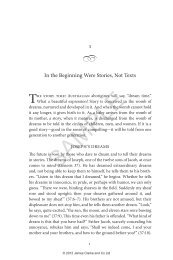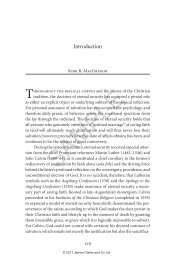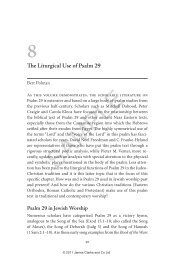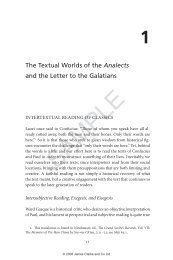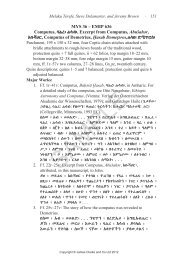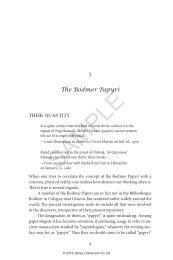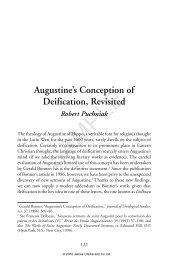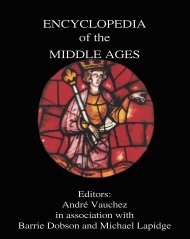The Spirit of Anglicanism, by Paul Elmer More - James Clarke and ...
The Spirit of Anglicanism, by Paul Elmer More - James Clarke and ...
The Spirit of Anglicanism, by Paul Elmer More - James Clarke and ...
You also want an ePaper? Increase the reach of your titles
YUMPU automatically turns print PDFs into web optimized ePapers that Google loves.
FOREWORD<br />
THE MAKING OF MORE AND CROSS’ ANGLICANISM<br />
By<br />
W. Brown Patterson<br />
<strong>Anglicanism</strong>, edited <strong>by</strong> <strong>Paul</strong> <strong>Elmer</strong> <strong>More</strong> <strong>and</strong> Frank Leslie Cross, first published in 1935,<br />
was reprinted in 1951, 1957, <strong>and</strong> 1962, becoming a st<strong>and</strong>ard work. <strong>The</strong> collection, with its<br />
valuable editorial features, defined what the editors called “the thought <strong>and</strong> practice <strong>of</strong> the<br />
Church <strong>of</strong> Engl<strong>and</strong>” in a new way. <strong>The</strong> book has retained its salience <strong>and</strong> relevance. <strong>The</strong><br />
current controversies over doctrinal <strong>and</strong> other issues in the worldwide Anglican Communion<br />
– threatening its unity <strong>and</strong> effectiveness – make a reprint edition <strong>of</strong> the book extremely<br />
welcome. <strong>The</strong> richness <strong>and</strong> diversity <strong>of</strong> the religious literature <strong>of</strong> the Church <strong>of</strong> Engl<strong>and</strong> in the<br />
seventeenth century are more fully revealed in this volume than anywhere else.<br />
<strong>The</strong> selections in <strong>Anglicanism</strong> demonstrate that a century noted for the brilliance <strong>of</strong> its<br />
poetry, drama, <strong>and</strong> prose was also one <strong>of</strong> the most fruitful in English history in terms <strong>of</strong><br />
religious thought. Many <strong>of</strong> these creative achievements were accompanied <strong>and</strong> provoked <strong>by</strong><br />
revolutionary political events <strong>and</strong> <strong>by</strong> bitter religious <strong>and</strong> intellectual disputes. <strong>The</strong> religious<br />
ideas <strong>and</strong> values <strong>of</strong> a broad range <strong>of</strong> writers deserve, as <strong>More</strong> argues in his introductory essay,<br />
the renewed attention <strong>of</strong> all those who seek to underst<strong>and</strong> a remarkable era.<br />
<strong>The</strong> term <strong>Anglicanism</strong>, used <strong>by</strong> the editors as the title for their collection <strong>of</strong> excerpts from<br />
the religious writings <strong>of</strong> the seventeenth century, refers to the doctrine <strong>and</strong> discipline <strong>of</strong> the<br />
established Church <strong>of</strong> Engl<strong>and</strong>. But the term is <strong>of</strong> later origin than the writings, <strong>and</strong> needs<br />
definition. 1 Though the word Anglican was occasionally used in the seventeenth century to<br />
describe the English Church as it emerged from the Reformation <strong>of</strong> the previous century, it<br />
took until the mid-nineteenth century for the term <strong>Anglicanism</strong> to be widely used. It was part<br />
<strong>of</strong> the vocabulary <strong>of</strong> members <strong>of</strong> the Oxford movement, a group <strong>of</strong> clergy <strong>and</strong> lay people who<br />
sought to recover for the established Church some <strong>of</strong> the distinctive theological emphases <strong>of</strong><br />
the pre-Reformation period. <strong>The</strong> Tractarians, as John Henry Newman, Edward Pusey, John<br />
Keble, <strong>and</strong> others were called, from their authorship <strong>of</strong> Tracts for the Times (1834-1841),<br />
claimed that the Church <strong>of</strong> Engl<strong>and</strong>, though reformed, was the historic Catholic Church <strong>of</strong><br />
the isl<strong>and</strong> <strong>and</strong> that the Catholicism <strong>of</strong> its spiritual heritage was broader <strong>and</strong> purer than Roman<br />
Catholicism. According to the Oxford English Dictionary, the term <strong>Anglicanism</strong> was used,<br />
beginning in 1838, to mean “Adherence to the doctrine <strong>and</strong> discipline <strong>of</strong> the reformed Church<br />
<strong>of</strong> Engl<strong>and</strong> (<strong>and</strong> other churches in communion therewith), as the genuine representative <strong>of</strong> the<br />
Catholic Church.” 2 <strong>The</strong> Church <strong>of</strong> Engl<strong>and</strong> <strong>and</strong> its daughter churches around the world were<br />
considered <strong>by</strong> Newman <strong>and</strong> his followers to be a via media between Protestantism <strong>and</strong> Roman<br />
SAMPLE<br />
1. <strong>The</strong> Oxford English Dictionary, second edition, ed. J.A. Simpson <strong>and</strong> E.S.C. Weiner, 20 vols. (Oxford:<br />
Clarendon Press, 1989), Vol. I, p. 464; Stephen Sykes, “Anglican thought,” in <strong>The</strong> Oxford Companion to Christian<br />
Thought, ed. Adrian Hastings, Alistair Mason, <strong>and</strong> Hugh Pyper (Oxford: Oxford University Press, 2000), pp.<br />
18-22. For a discussion <strong>of</strong> nineteenth-century English views <strong>of</strong> seventeenth-century theology, <strong>and</strong> <strong>of</strong> the<br />
emergence <strong>of</strong> the concept <strong>of</strong> <strong>Anglicanism</strong>, see Peter Knockles, “Survivals or New Arrivals? <strong>The</strong> Oxford<br />
Movement <strong>and</strong> the Nineteenth-Century Historical Construction <strong>of</strong> <strong>Anglicanism</strong>,” in <strong>Anglicanism</strong> <strong>and</strong> the Western<br />
Christian Tradition: Continuity, Change <strong>and</strong> the Search for Communion, ed. Stephen Platten (Norwich: Canterbury<br />
Press, 2003), pp. 144-191.<br />
2. Oxford English Dictionary, Vol. I, p. 464.<br />
xvii<br />
© 2009 <strong>James</strong> <strong>Clarke</strong> <strong>and</strong> Co Ltd
xviii<br />
CONTENTS<br />
Catholicism (a view that tended to obscure the English Church’s deep roots in the Protestant<br />
Reformation <strong>of</strong> the sixteenth century). <strong>More</strong> <strong>and</strong> Cross, writing in the mid-1930s, certainly<br />
held to the Tractarian view <strong>of</strong> the English Church as a via media, <strong>and</strong> the organisation <strong>and</strong><br />
contents <strong>of</strong> their collection reflect this view.<br />
<strong>Paul</strong> <strong>Elmer</strong> <strong>More</strong> was a prominent American editor <strong>and</strong> literary critic. 1 Born in St. Louis,<br />
Missouri, in 1864, he was educated there at Washington University <strong>and</strong> then at Harvard<br />
University. <strong>More</strong> was skilled in the ancient languages <strong>of</strong> Greek, Latin, Hebrew, <strong>and</strong> Sanscrit,<br />
as well as in French, Italian, Spanish, <strong>and</strong> German. H.L. Mencken, a rival editor <strong>and</strong> literary<br />
critic, said <strong>of</strong> him in 1922: “<strong>More</strong> has a solid stock <strong>of</strong> learning in his lockers; he is armed <strong>and</strong><br />
outfitted as none <strong>of</strong> the pollyannas who trail after him is armed <strong>and</strong> outfitted; he is, perhaps,<br />
the nearest approach to a genuine scholar that we have in America, God save us all!” 2 After<br />
teaching at Bryn Mawr College in Pennsylvania for two years, following his graduate studies<br />
at Harvard, <strong>More</strong> spent two years in seclusion – not unlike the sojourn <strong>of</strong> his countryman<br />
Henry David Thoreau – living in a hilltop cottage in Shelburne, New Hampshire, surrounded<br />
<strong>by</strong> fir trees <strong>and</strong> overlooking the Androscoggin River. One result <strong>of</strong> his stay was his decision to<br />
become a literary journalist <strong>and</strong> critic rather than a poet, which had been his earlier ambition.<br />
<strong>More</strong> subsequently became the literary editor <strong>of</strong> the Independent (1901-1903) <strong>and</strong> the New<br />
York Evening Post (1903-1906). He was first the literary editor <strong>and</strong> later the editor <strong>of</strong> <strong>The</strong><br />
Nation (1906-1914). <strong>The</strong> Nation was the leading weekly intellectual journal in the United<br />
States, <strong>and</strong> there he succeeded, as Robert Shafer has written, in “holding together <strong>and</strong> notably<br />
strengthening a very distinguished group <strong>of</strong> regular contributors”. 3 <strong>More</strong> wrote extensively for<br />
these periodicals. Many <strong>of</strong> his essays <strong>and</strong> reviews were separately published in a series <strong>of</strong> eleven<br />
volumes called Shelburne Essays (1904-1921).<br />
In 1914 <strong>More</strong>’s career entered a new phase when he resigned from <strong>The</strong> Nation <strong>and</strong> moved to<br />
Princeton, New Jersey, to become an independent scholar, a life made possible <strong>by</strong> an inheritance<br />
received <strong>by</strong> his wife, Henrietta Beck. He also taught Greek <strong>and</strong> philosophy on a continuing,<br />
though part-time, basis at Princeton University. During his years in Princeton <strong>More</strong> became<br />
more <strong>and</strong> more interested in Plato, Platonism, <strong>and</strong> the emergence <strong>of</strong> early Christianity. One<br />
result <strong>of</strong> these interests was an impressive five-volume work entitled <strong>The</strong> Greek Tradition (1924-<br />
1931). <strong>The</strong> 1920s were also years in which he was closely associated with Irving Babbitt, whom<br />
he had first met when they were fellow students at Harvard. <strong>The</strong> literary movement that they<br />
led came to be called the New Humanism. 4 Babbitt had become a pr<strong>of</strong>essor <strong>of</strong> comparative<br />
literature at Harvard, where he was a popular lecturer <strong>and</strong> an influential adviser. <strong>The</strong> humanism<br />
that <strong>More</strong> <strong>and</strong> Babbitt championed owed a great deal to Matthew Arnold. <strong>More</strong> <strong>and</strong> Babbitt<br />
favored literary classics that threw light on the human condition <strong>and</strong> provided insights about<br />
the character <strong>of</strong> the moral life. <strong>The</strong>y were indifferent or opposed to literary study as a vehicle<br />
for social criticism, <strong>and</strong> they deplored an easy relativism in the assessment <strong>of</strong> ideas <strong>and</strong> values.<br />
<strong>The</strong>y were opposed to the individualism that characterized late Romanticism <strong>and</strong> to pretensions<br />
to objectivity <strong>by</strong> the proponents <strong>of</strong> modern science. In the 1920s the movement attracted<br />
SAMPLE<br />
1. See Robert Shafer, <strong>Paul</strong> <strong>Elmer</strong> <strong>More</strong> <strong>and</strong> American Criticism (New Haven: Yale University Press, 1935);<br />
Arthur Hazard Dakin, <strong>Paul</strong> <strong>Elmer</strong> <strong>More</strong> (Princeton: Princeton University Press, 1960); <strong>and</strong> Francis X. Duggan,<br />
<strong>Paul</strong> <strong>Elmer</strong> <strong>More</strong> (New York: Twayne Publishers, 1966).<br />
2. Shafer, <strong>Paul</strong> <strong>Elmer</strong> <strong>More</strong>, p. 314.<br />
3. Ibid., p. 109.<br />
4. See Irving Babbitt, Character <strong>and</strong> Culture: Essays on East <strong>and</strong> West (New Brunswick, New Jersey: Transaction<br />
Publishers, 1995), esp. the introduction <strong>by</strong> Claes G. Ryn, pp. ix-l.<br />
© 2009 <strong>James</strong> <strong>Clarke</strong> <strong>and</strong> Co Ltd
xix<br />
many younger critics <strong>and</strong> adherents, though after about 1930 the movement lost favor. It was<br />
attacked <strong>by</strong> those who found humanism without religion to lack substance <strong>and</strong> <strong>by</strong> those who<br />
preferred to approach literature <strong>by</strong> means <strong>of</strong> a close reading <strong>of</strong> texts as works <strong>of</strong> art.<br />
Meanwhile <strong>More</strong> underwent a spiritual conversion that he described in Pages from an<br />
Oxford Diary, written while he was at Oxford University in 1924-25. <strong>The</strong> book purports to be<br />
the journal <strong>of</strong> a fellow <strong>of</strong> a college at Oxford, but it is an account <strong>of</strong> <strong>More</strong>’s own experiences,<br />
as he acknowledged in the preface to the book when it was finally published in 1937. 1 This<br />
was the year in which he died. <strong>The</strong> Oxford don who is the narrator in the diary came to feel<br />
the presence <strong>of</strong> John Henry Newman in an almost palpable way: “I can see him moving<br />
with his long swift strides through the lanes about Iffley <strong>and</strong> Littlemore; the quadrangle <strong>of</strong><br />
Oriel for his sake is forever a hallowed spot.” 2 <strong>The</strong> don recognized in Newman someone who<br />
had pursued a spiritual quest much like his own. Newman recalled that St. Augustine, who<br />
also sought God over his lifetime, had said: “he knew only two things, God <strong>and</strong> his own<br />
soul”. 3 <strong>The</strong> don summed up the stages in his own quest: “childish faith, romanticism, critical<br />
curiosity, classical taste, Platonism”. 4 At last the don had come to an underst<strong>and</strong>ing <strong>of</strong> God as<br />
the Creator who was <strong>and</strong> is struggling against great obstacles to bring order out <strong>of</strong> chaos. In<br />
a glorious Epiphany, God had revealed himself to the world in his Son, Jesus Christ, through<br />
whom human beings could come to know the Father. <strong>The</strong> don saw the Eucharist as a powerful<br />
symbol <strong>and</strong> force, continuing the work <strong>of</strong> the Incarnation <strong>of</strong> the Eternal Word in Christ:<br />
“best <strong>of</strong> all I like to consider it [the Eucharist] as completing, so to speak, that event <strong>by</strong> which<br />
the Word became flesh, <strong>and</strong> as showing on a thous<strong>and</strong> altars how flesh becomes the Word.” 5<br />
He rejected the explanation <strong>of</strong> the sacrament <strong>by</strong> the followers <strong>of</strong> Zwingli <strong>and</strong> <strong>by</strong> the Roman<br />
Catholics. <strong>The</strong> Zwinglian doctrine, which held that the sacrament was a memorial <strong>of</strong> the Last<br />
Supper, “deprives the act <strong>of</strong> all potency over the imagination”. <strong>The</strong> Roman Catholic doctrine<br />
<strong>of</strong> transubstantiation, “founded on a metaphysical distinction <strong>of</strong> substance <strong>and</strong> attributes<br />
is untenable”. 6 <strong>The</strong> don declared that he embraced “the wisdom <strong>and</strong> modesty <strong>of</strong> our great<br />
Anglican divines, who, from the days <strong>of</strong> Henry VIII to the present, have resolutely refrained<br />
from analyzing the operation <strong>of</strong> the sacrament, <strong>and</strong> have felt its efficacy as a mystery to be felt<br />
<strong>and</strong> not propounded”. 7<br />
<strong>More</strong>’s earliest description <strong>of</strong> the projected work that became <strong>Anglicanism</strong> was in a letter to<br />
the poet <strong>and</strong> critic T.S. Eliot. He had dined with Eliot in 1928 during a trip to Engl<strong>and</strong>. Eliot<br />
had severely criticized the New Humanism as expounded <strong>by</strong> Babbitt, on the grounds that it<br />
lacked an explicitly religious focus. He evidently saw in <strong>More</strong> someone whose interests were<br />
closer to his own. In <strong>More</strong>’s letter to Eliot in July 1930, he said that he had a great deal to relate<br />
“about a great project for an anthology from the 17 th century to show the ethos <strong>of</strong> the Anglican<br />
Church”. He continued: “After all theology is the only really interesting subject, <strong>and</strong> I get so<br />
little <strong>of</strong> it in conversation or letters.” 8 By the late summer <strong>of</strong> 1931, <strong>More</strong> had asked Frank Leslie<br />
Cross to assist him with the project. In a letter <strong>of</strong> September 1931 to his friend Prosser Hall<br />
SAMPLE<br />
1. <strong>Paul</strong> <strong>Elmer</strong> <strong>More</strong>, Pages from an Oxford Diary (Princeton: Princeton University Press, 1937), Preface (the<br />
book lacks pagination).<br />
2. Ibid., Sect. III.<br />
3. Ibid.<br />
4. Ibid., Sect. XXIX.<br />
5. Ibid., Sect. XXX.<br />
6. Ibid.<br />
7. Ibid.<br />
8. Dakin, <strong>Paul</strong> <strong>Elmer</strong> <strong>More</strong>, p. 292. For <strong>More</strong>’s evening with T.S. Eliot in 1928, see p. 262.<br />
© 2009 <strong>James</strong> <strong>Clarke</strong> <strong>and</strong> Co Ltd
xx<br />
Frye, a literary scholar, <strong>More</strong> said that he had journeyed from Edinburgh to Oxford, “where I<br />
engaged an assistant for the project ‘corpus,’ <strong>and</strong> so back to Cambridge”. He continued:<br />
Have I told you about the ‘corpus’? It is to be an anthology . . . including<br />
sermons, chapters from books, documents <strong>of</strong> all sorts, to illustrate the ethos <strong>of</strong><br />
the Anglican Church in the period from Hooker to Ken. It is to be published<br />
<strong>by</strong> the S.P.C.K. Through Bishop [Philip Mercer] Rhinel<strong>and</strong>er <strong>of</strong> the College <strong>of</strong><br />
Preachers, Washington, money has been raised to pay a salary to an assistant<br />
editor for two years, <strong>and</strong> it was this assistant [Frank Leslie Cross] I engaged at<br />
Oxford. He is a young priest, now at Pusey House, who I think is thoroughly<br />
well qualified for the work. 1<br />
In March <strong>and</strong> April 1932, <strong>More</strong> devoted “fifteen or twenty days” to working with Cross in<br />
Princeton planning the anthology. 2 By the early summer <strong>of</strong> 1933 <strong>More</strong> was back in Oxford,<br />
where, among other activities, he met C.S. Lewis, “who interested me more than any other<br />
Oxonian I have met in a long time,” as he wrote to Babbitt. Lewis promised to send a book to<br />
<strong>More</strong>, once it was published, that described in a disguised form Lewis’s own spiritual journey.<br />
This was <strong>The</strong> Pilgrim’s Regress (1933). 3 <strong>More</strong> said <strong>of</strong> his work with Cross on the anthology <strong>of</strong><br />
religious writers: “My mornings I spent with Cross in the Bodleian or Pusey House going<br />
through masses <strong>of</strong> bulky volumes, some <strong>of</strong> which, as shown <strong>by</strong> uncut leaves, have never been<br />
read here before.” 4 Toward the end <strong>of</strong> July 1933, <strong>More</strong> reported that Cross was “collating the<br />
texts, reading pro<strong>of</strong>, <strong>and</strong> attending to the notes”. 5 In late September 1933, in a letter to Eliot<br />
written from Princeton, <strong>More</strong> reported that he had read the third draft <strong>of</strong> his introduction to<br />
the volume to several friends, who “seemed to feel that my view <strong>of</strong> <strong>Anglicanism</strong> was correct<br />
<strong>and</strong> enlightening”. 6 He added: “This, as far as it goes, is encouraging, since the work has cost<br />
infinite pains <strong>and</strong> even so has left me very anxious.” 7 Early in 1935 <strong>More</strong> wrote with some<br />
satisfaction to the critic <strong>and</strong> editor Seward B. Collins: “the opus ‘<strong>Anglicanism</strong>’ will soon appear<br />
heralded with recommendations <strong>by</strong> the Archbishops <strong>of</strong> Canterbury <strong>and</strong> York [Cosmo Gordon<br />
Lang <strong>and</strong> William Temple] <strong>and</strong> <strong>by</strong> T. S. Eliot.” 8 <strong>The</strong> book appeared later in the same year.<br />
Frank Leslie Cross, whose career intersected with <strong>More</strong>’s in 1931, was born in 1900<br />
<strong>and</strong> was thus a full generation younger than <strong>More</strong>, but he was already an accomplished <strong>and</strong><br />
productive scholar. 9 Cross had in earlier years devoted himself primarily to the natural sciences<br />
<strong>and</strong> mathematics as a pupil at Bournemouth School <strong>and</strong> then at Balliol College, Oxford. He<br />
completed the first part <strong>of</strong> the honours course in chemistry at Oxford in 1920. In the same year<br />
he earned an external B.Sc. degree in chemistry at the University <strong>of</strong> London. About then his<br />
SAMPLE<br />
1. Ibid., p. 301.<br />
2. Ibid., p. 327 note.<br />
3. Ibid., p. 327.<br />
4. Ibid.<br />
5. Ibid., p. 330.<br />
6. Ibid., p. 334.<br />
7. Ibid., p. 335.<br />
8. Ibid., p. 370.<br />
9. See T.M. Parker, “Frank Leslie Cross, 1900-1968,” Proceedings <strong>of</strong> the British Academy, 1969, pp. 362-375;<br />
E.A. Livingstone, “Frank Leslie Cross, 1900-1968,” <strong>The</strong> Oxford Dictionary <strong>of</strong> the Christian Church, second edition,<br />
ed. F.L. Cross <strong>and</strong> E.A. Livingstone (London: Oxford University Press, 1974), pp. xxvii-xxxi; <strong>and</strong> Elizabeth<br />
A. Livingston, “Cross, Frank Leslie (1900-1968),” Oxford Dictionary <strong>of</strong> National Biography (Oxford; Oxford<br />
University Press, 2004), http://0-www.oxforddnb.com.<br />
© 2009 <strong>James</strong> <strong>Clarke</strong> <strong>and</strong> Co Ltd
xxi<br />
interests took a decidedly different path. Cross received the B.A. degree in theology at Oxford<br />
in 1922, <strong>and</strong>, in recognition <strong>of</strong> his distinguished academic work, he was awarded the Senior<br />
Denyer <strong>and</strong> Johnson Scholarship, which enabled him to pursue theology in Germany for two<br />
years at the universities <strong>of</strong> Marburg <strong>and</strong> Freiburg. He subsequently received the D. Phil. degree<br />
in theology at Oxford. Meanwhile he was ordained a deacon in 1925 <strong>and</strong> a priest in 1926. He<br />
served as tutor <strong>and</strong> chaplain at Ripon Hall theological college in Oxford, <strong>and</strong> in 1927 became<br />
librarian at Pusey House, Oxford. Pusey House continued the theological emphases <strong>of</strong> the<br />
Oxford Movement <strong>and</strong> was the spiritual home <strong>of</strong> a community <strong>of</strong> like-minded students <strong>and</strong><br />
advanced scholars. While <strong>Paul</strong> <strong>Elmer</strong> <strong>More</strong> was a wide-ranging literary critic who, as a layman,<br />
became deeply interested in English theology in the seventeenth century, Frank Leslie Cross<br />
was a scientist-become-theologian with exceptional academic credentials, who as an ordained<br />
priest devoted himself to pastoral <strong>and</strong> liturgical activities as well as to scholarship.<br />
<strong>More</strong> <strong>and</strong> Cross, so different in some ways, had a great deal in common. By the time Cross<br />
had moved from Ripon Hall to Pusey House, he had evidently changed from a “modernist”<br />
or liberal theological orientation to the Anglo-Catholicism associated with the followers <strong>and</strong><br />
spiritual descendants <strong>of</strong> the Tractarians. This orientation had given Cross a keen interest in<br />
the writings <strong>of</strong> the seventeenth-century English divines that so much interested <strong>More</strong>. In<br />
John Henry Newman (1933), Cross commented: “<strong>The</strong> Oxford Movement was theologically<br />
a return to the pure undiluted religious outlook <strong>of</strong> the Seventeenth Century.” 1 He added<br />
that its members took their fundamental principles on “the authority <strong>of</strong> the great Divines<br />
<strong>of</strong> the Seventeenth Century, – Andrewes, Laud, Hammond, Cosin”. 2 Cross acknowledged<br />
that Newman <strong>and</strong> his associates had formulated the doctrine <strong>of</strong> the Church <strong>of</strong> Engl<strong>and</strong> as<br />
the via media or middle way between Protestantism <strong>and</strong> Roman Catholicism <strong>and</strong> he noted<br />
that Newman, in his Lectures on the Prophetical Offi ce <strong>of</strong> the Church (1837 – eight years before<br />
becoming a Roman Catholic) had provided “a magnificent apologia for what may be termed<br />
the Anglican ethos”. 3<br />
Cross had already published several books before he met <strong>More</strong>. He had edited, with<br />
H.D.A. Major, the principal <strong>of</strong> Ripon Hall, three volumes <strong>of</strong> the papers <strong>of</strong> the theologian <strong>and</strong><br />
historian Hastings Rashdall (published in 1927-1930). He had also written Religion <strong>and</strong> the<br />
Reign <strong>of</strong> Science (1930), drawing on his studies <strong>of</strong> the scientific disciplines, in which he argued<br />
that religion <strong>and</strong> science were not only compatible but were necessary partners in the quest<br />
for knowledge <strong>and</strong> meaning in the natural world. He had become intensely interested in the<br />
ancient Greek <strong>and</strong> Latin Fathers <strong>of</strong> the Church, an interest that closely paralleled <strong>More</strong>’s. His<br />
editing <strong>of</strong> <strong>Anglicanism</strong> with <strong>More</strong> was evidently one reason that his subsequent career took the<br />
turn it did. <strong>The</strong> assiduous, painstaking, <strong>and</strong> almost archaeological work involved in uncovering<br />
the English theological literature <strong>of</strong> the seventeenth century helped to lay the foundation for<br />
his most important <strong>and</strong> enduring scholarly publication. This was <strong>The</strong> Oxford Dictionary <strong>of</strong> the<br />
Christian Church (1957, with later editions in 1974, 1997, <strong>and</strong> 2005, the last three under the<br />
editorship also <strong>of</strong> E.A. Livingstone), which he founded <strong>and</strong> edited, recruiting many scholars as<br />
contributors, <strong>and</strong> to which he contributed a great many articles. Commissioned <strong>by</strong> Ge<strong>of</strong>frey<br />
Cumberlege <strong>of</strong> Oxford University Press in 1939, it was no doubt under way considerably<br />
earlier.<br />
Cross would continue his distinguished career for more than three decades after <strong>More</strong>’s<br />
SAMPLE<br />
1. Frank Leslie Cross, John Henry Newman (London: Philip Allan, 1933), p. 23.<br />
2. Ibid., p. 24.<br />
3. Ibid., pp. 65, 70.<br />
© 2009 <strong>James</strong> <strong>Clarke</strong> <strong>and</strong> Co Ltd
xxii<br />
death in 1937. In 1943 he published Darwell Stone, Churchman <strong>and</strong> Counselor, an account<br />
<strong>of</strong> the life <strong>and</strong> career <strong>of</strong> the principal <strong>of</strong> Pusey House, 1909-1934, known particularly for his<br />
scholarly work on the history <strong>of</strong> the doctrine <strong>of</strong> the Eucharist. In 1944, Cross became Lady<br />
Margaret Pr<strong>of</strong>essor <strong>of</strong> Divinity at Oxford <strong>and</strong> a canon <strong>of</strong> Christ Church Cathedral. Reflecting<br />
his deep interest in patristic history <strong>and</strong> theology, he founded the series <strong>of</strong> international<br />
conferences on patristic studies that began in Oxford in 1951. Connected with this interest<br />
were his editing <strong>of</strong> St. Athanasius’s De Incarnatione (1939), St. Cyril <strong>of</strong> Jerusalem’s Lectures on the<br />
Christian Sacraments (1951), <strong>and</strong> <strong>The</strong> Early Christian Fathers (1960). His death came quietly<br />
at <strong>The</strong> Priory House at Christ Church in 1968. <strong>Anglicanism</strong> was, in the case <strong>of</strong> <strong>More</strong>, a final<br />
scholarly achievement; it was, for Cross, a formative <strong>and</strong> highly significant early work.<br />
<strong>Anglicanism</strong> was not a collection <strong>of</strong> extracts that were all strictly theological. As the subtitle<br />
stated, the collection was to bring to the readers’ attention not only religious literature <strong>of</strong> a<br />
variety <strong>of</strong> kinds but some <strong>of</strong> the distinctive practices <strong>of</strong> the English Church during a crucially<br />
important century. <strong>The</strong> title-page bore a quotation from John Henry Newman’s Lectures on<br />
the Prophetical Offi ce <strong>of</strong> the Church which stated succinctly <strong>and</strong> prophetically what the editors<br />
sought to accomplish: “We have a vast inheritance, but no inventory <strong>of</strong> our treasures. All<br />
is given in pr<strong>of</strong>usion; it remains for us to catalogue, sort, distribute, select, harmonize, <strong>and</strong><br />
complete.” <strong>The</strong> publisher, S.P.C.K. (the Society for the Promotion <strong>of</strong> Christian Knowledge),<br />
had been founded, appropriately, in 1698, “to advance the honour <strong>of</strong> God <strong>and</strong> the good <strong>of</strong><br />
mankind, <strong>by</strong> promoting Christian knowledge both at home <strong>and</strong> in other parts <strong>of</strong> the world”. 1<br />
<strong>The</strong> preface <strong>by</strong> <strong>More</strong> recounted the process <strong>by</strong> which the book had taken shape, elaborating<br />
on the description he had sent to Eliot several years earlier. <strong>More</strong> had, in 1931, mentioned his<br />
plan to Bishop Philip Mercer Rhinel<strong>and</strong>er, the former bishop <strong>of</strong> Pennsylvania who had become<br />
the warden <strong>of</strong> the College <strong>of</strong> Preachers at the National Cathedral <strong>of</strong> the American Episcopal<br />
Church in Washington, D.C. Rhinel<strong>and</strong>er invited <strong>More</strong> to present the plan to a committee<br />
that included the deans or heads <strong>of</strong> three Episcopal theological seminaries: Hughell Edgar<br />
Woodall Fosbroke <strong>of</strong> the General <strong>The</strong>ological Seminary in New York City, Henry Bradford<br />
Washburn <strong>of</strong> the Episcopal <strong>The</strong>ological School in Cambridge, Massachusetts, <strong>and</strong> William<br />
Palmer Ladd <strong>of</strong> the Berkeley Divinity School in New Haven, Connecticut. Frank Gavin,<br />
pr<strong>of</strong>essor <strong>of</strong> ecclesiastical history at General Seminary, was also a member. <strong>The</strong> committee <strong>and</strong><br />
the bishop endorsed the plan <strong>and</strong> undertook to raise funds to make possible the appointment<br />
<strong>of</strong> an associate editor <strong>and</strong> to cover “incidental expenses”. <strong>The</strong> members left the organization<br />
<strong>and</strong> editing <strong>of</strong> the book entirely in the editors’ h<strong>and</strong>s. <strong>More</strong> engaged Cross in the project,<br />
<strong>and</strong> he acknowledged that his coeditor had taken on “much the heavier part <strong>of</strong> the burden <strong>of</strong><br />
reading <strong>and</strong> editing”. <strong>The</strong> purpose <strong>of</strong> the projected volume was, as <strong>More</strong> wrote, “to make a<br />
collection <strong>of</strong> passages from the ecclesiastical writers <strong>of</strong> the Seventeenth Century which would<br />
set forth the doctrine <strong>and</strong> discipline, – what might be called in a broad sense the genius, – <strong>of</strong><br />
the Church <strong>of</strong> Engl<strong>and</strong> in that age <strong>of</strong> adjustment after the first confusions <strong>of</strong> the Reformation”.<br />
<strong>The</strong> two editors said <strong>of</strong> their h<strong>and</strong>iwork that they believed “that the documents here assembled<br />
represent what was clearly the dominant teaching <strong>of</strong> the Anglican Church in that age”.<br />
<strong>The</strong> volume contained writings <strong>by</strong> 102 authors, including a few who wrote anonymously.<br />
<strong>The</strong>se writers make up a remarkably diverse group. Included among them are the forerunners <strong>of</strong><br />
the Laudian movement such as Lancelot Andrewes <strong>and</strong> John Overall; the Laudians themselves<br />
such as William Laud, John Cosin, <strong>and</strong> Jeremy Taylor; moderate Calvinists such as Joseph<br />
Hall <strong>and</strong> John Davenant; Cambridge Platonists such as Henry <strong>More</strong> <strong>and</strong> Ralph Cudworth;<br />
1. Oxford Dictionary <strong>of</strong> the Christian Church, second edition, p. 1298.<br />
SAMPLE<br />
© 2009 <strong>James</strong> <strong>Clarke</strong> <strong>and</strong> Co Ltd
xxiii<br />
Restoration high churchmen such as William Sancr<strong>of</strong>t <strong>and</strong> Thomas Ken; <strong>and</strong> Latitudinarians<br />
such as Gilbert Burnet <strong>and</strong> John Tillotson. Also included are religious writers more difficult to<br />
define theologically: the liberal William Chillingworth, the ex-Roman Catholic Marco Antonio<br />
de Dominis, the conciliarist theologian Richard Field, <strong>and</strong> the Cambridge linguist <strong>and</strong> scholar<br />
Herbert Thorndike. Well known literary figures include Francis Bacon, John Donne, George<br />
Herbert, Thomas Browne, Isaak Walton, Thomas Traherne, <strong>and</strong> John Evelyn. <strong>The</strong> historian <strong>and</strong><br />
statesman Edward Hyde is here, as is the epoch-making scientist Isaac Newton. Two monarchs<br />
are included: <strong>James</strong> I <strong>and</strong> Charles I. <strong>The</strong> apologist for the Elizabethan Church, Richard Hooker,<br />
who died in 1600, is one <strong>of</strong> the writers most frequently represented. Brief biographies <strong>of</strong> all <strong>of</strong><br />
the writers are included as an appendix to the volume. An informative, though now necessarily<br />
dated, account <strong>of</strong> the historical context is provided <strong>by</strong> an introductory essay <strong>by</strong> Felix R. Arnott,<br />
then <strong>of</strong> Keble College, Oxford, later archbishop <strong>of</strong> Brisbane in Australia. Conspicuously<br />
missing from the collection are most <strong>of</strong> the nonconformists, usually called Puritans, who were<br />
indubitably members <strong>of</strong> the Church <strong>of</strong> Engl<strong>and</strong> in the early seventeenth century. Also missing<br />
are many <strong>of</strong> the writers in the Interregnum in the middle <strong>of</strong> the century who took theology <strong>and</strong><br />
ecclesiastical practice in radically new directions. Richard Baxter, a nonconformist after the<br />
Restoration whose theology was broad <strong>and</strong> whose view <strong>of</strong> the national church was inclusive,<br />
does find a place here. In general, the moderate Calvinist tradition that prevailed in the English<br />
Church at the beginning <strong>of</strong> the seventeenth century is underrepresented. But the rich diversity<br />
<strong>of</strong> thinkers who are included justify the author’s assessment <strong>of</strong> the seventeenth century as a<br />
golden age in the history <strong>of</strong> English religious literature.<br />
<strong>More</strong> <strong>and</strong> Cross grouped the excerpts in the collection into nineteen chapters. Some <strong>of</strong><br />
chapters are largely theological, <strong>and</strong> include such topics as the Bible, St<strong>and</strong>ards <strong>of</strong> Faith, Natural<br />
<strong>The</strong>ology, Soteriology, Eschatology, <strong>and</strong> the Sacraments. Others incline toward ecclesiastical<br />
organization <strong>and</strong> practice, including the Christian Ministry, Baptism <strong>and</strong> Confirmation,<br />
Visitations (<strong>of</strong> parishes <strong>by</strong> the diocesan bishop), <strong>and</strong> Prayer. <strong>The</strong> volume opens with broad<br />
categories relating to the character <strong>of</strong> the English Church, including the Anglican Faith, the<br />
Church, <strong>and</strong> Separated Churches, <strong>and</strong> closes with Caroline Piety, or the spirituality <strong>of</strong> the<br />
English Church in the reigns <strong>of</strong> Charles I <strong>and</strong> Charles II. Throughout the book, writers are<br />
shown to be concerned with preserving the integrity <strong>of</strong> the Church <strong>of</strong> Engl<strong>and</strong> in the face<br />
<strong>of</strong> repeated challenges from many different quarters – intellectual, political, <strong>and</strong> social. <strong>The</strong><br />
book resembles a summa theologica or systematic theology <strong>of</strong> the English Church that is more<br />
detailed than any writer or group <strong>of</strong> writers had ever attempted. <strong>The</strong> Church <strong>of</strong> Engl<strong>and</strong>,<br />
which did not have any one theologian as central to its life as Thomas Aquinas, Luther, or<br />
Calvin are to other traditions, had something that was better. That is, it had a body <strong>of</strong> writings<br />
that was consonant with broad agreed-upon principles <strong>of</strong> faith <strong>and</strong> order but was immensely<br />
varied in expression <strong>and</strong> interpretation. Further theological reflection seemed to be enjoined on<br />
successor generations <strong>by</strong> their work. Conciliar or consultative procedures would be appropriate.<br />
Further writing <strong>and</strong> discussion were, in effect, called for. Rather than attempting to freeze the<br />
English Church in a seventeenth-century form, the editors showed that the English Church<br />
<strong>of</strong> the seventeenth century was a living entity, responding to challenges <strong>and</strong> defining <strong>and</strong><br />
redefining its mission in relation to a constantly changing cultural environment. As <strong>More</strong><br />
wrote in his opening essay, entitled “<strong>The</strong> <strong>Spirit</strong> <strong>of</strong> <strong>Anglicanism</strong>”, “What we have to look for in<br />
the ecclesiastical literature <strong>of</strong> Engl<strong>and</strong> is not so much finality as direction.” He also stated his<br />
own belief “that a liberal ethos <strong>of</strong> Christianity,” such as that developed <strong>by</strong> many English writers<br />
in the seventeenth century, “will more <strong>and</strong> more prevail in the Holy Catholic Church”. <strong>The</strong><br />
SAMPLE<br />
© 2009 <strong>James</strong> <strong>Clarke</strong> <strong>and</strong> Co Ltd
xxiv<br />
modern Ecumenical Movement, the Second Vatican Council, <strong>and</strong> the widespread acceptance<br />
in the churches <strong>of</strong> the historical-critical study <strong>of</strong> the scriptures seem to bear out his confident<br />
assertion.<br />
T.S. Eliot, to whom <strong>More</strong> had confided his plan for the book at an early stage, was not<br />
entirely pleased with the eventual result. Writing in the Princeton Alumni Weekly early in<br />
February 1937, Eliot praised <strong>More</strong> for his multi-volume work, <strong>The</strong> Greek Tradition, in which<br />
<strong>More</strong> had, he said, demonstrated not only his intelligence <strong>and</strong> erudition but his personal<br />
engagement in the search for truth <strong>and</strong> for an underst<strong>and</strong>ing <strong>of</strong> God. But, Eliot said, <strong>More</strong>, in<br />
his introduction to <strong>Anglicanism</strong>, had failed “to emphasize the continuity <strong>of</strong> the Church; one<br />
might think that it was the invention <strong>of</strong> Hooker. He does not give recognition to the probable<br />
importance <strong>of</strong> the mystics <strong>of</strong> the fourteenth century – <strong>of</strong> Richard Rolle <strong>and</strong> Juliana <strong>of</strong> Norwich<br />
for instance – as late as the time <strong>of</strong> Lancelot Andrewes <strong>and</strong> George Herbert.” Nevertheless,<br />
Eliot added, “his underst<strong>and</strong>ing <strong>of</strong> the spirit <strong>of</strong> <strong>Anglicanism</strong> is remarkable”. 1 <strong>The</strong> subject, Eliot<br />
seemed to say, is eminently worth an intelligent reader’s attention. In any case this superbly<br />
edited anthology has proved to be extraordinarily durable, <strong>and</strong> it achieves new life with the<br />
present edition.<br />
SAMPLE<br />
W. Brown Patterson<br />
1. Dakin, <strong>Paul</strong> <strong>Elmer</strong> <strong>More</strong>, p. 385.<br />
© 2009 <strong>James</strong> <strong>Clarke</strong> <strong>and</strong> Co Ltd





